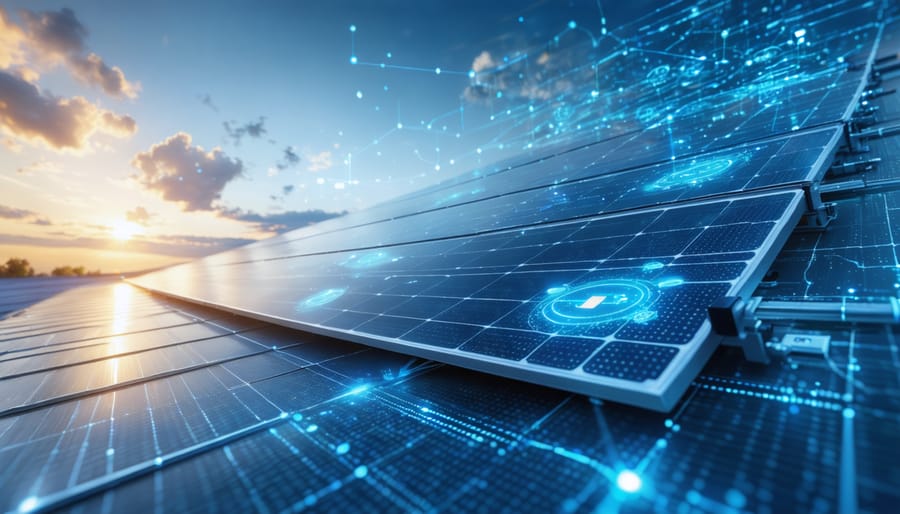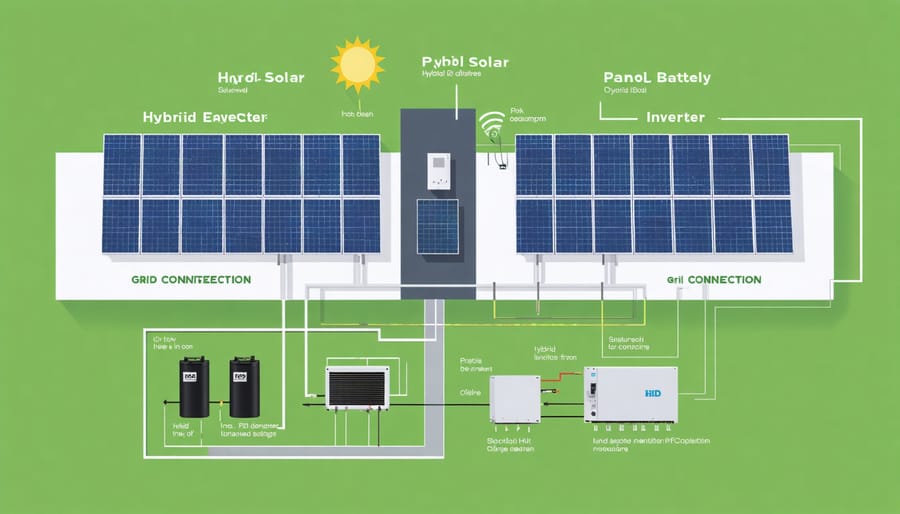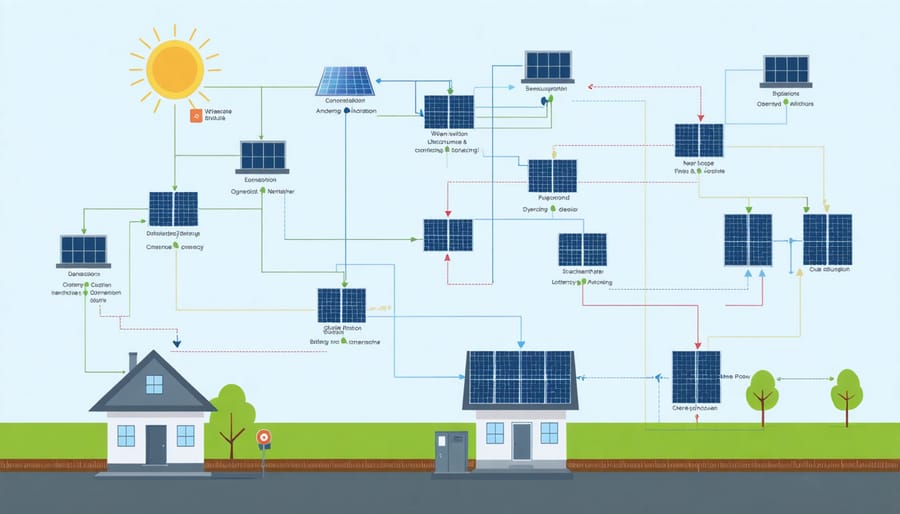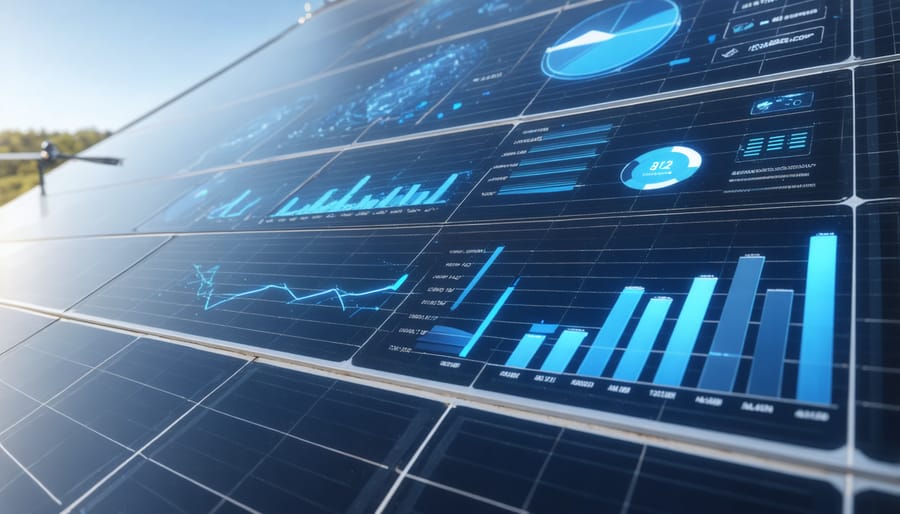How Hybrid Solar Systems Keep Your Power Running When the Grid Fails

Visualize the future of energy independence through a hybrid solar system – an ingenious combination of solar panels, battery storage, and intelligent power management that revolutionizes how European homes and businesses harness renewable energy. This sophisticated integration of photovoltaic technology with conventional power sources represents the pinnacle of modern energy solutions, offering unparalleled flexibility and reliability. A well-designed hybrid solar system seamlessly switches between solar power, battery storage, and grid electricity, ensuring continuous power supply while maximizing renewable energy utilization. Understanding these systems through detailed diagrams reveals their elegant complexity: from solar panels capturing sunlight on your roof to the intelligent inverters orchestrating power flow, every component plays a crucial role in this sustainable energy symphony. Whether you’re a homeowner seeking energy independence or a business aiming to reduce operational costs, grasping the fundamentals of hybrid solar system architecture is your first step toward a more sustainable and economically sound future.
Understanding the Components of a Hybrid Solar System

Solar Panels and Power Generation
In a hybrid solar system, photovoltaic (PV) panels form the cornerstone of power generation, converting sunlight into electrical energy through the photovoltaic effect. These panels, typically installed on rooftops or ground-mounted arrays, comprise multiple silicon cells that work together to produce direct current (DC) electricity.
Modern solar panels used in European installations typically offer efficiency ratings between 15% and 22%, with premium models pushing even higher. When sunlight strikes the panels, electrons are set in motion, generating electricity that flows through the system’s wiring to the inverter.
The power generation capacity depends on several factors, including panel orientation, tilt angle, and local solar irradiance levels. In optimal conditions, a typical 5kW system can generate 4,000 to 5,000 kWh annually in most European locations. The system’s smart controls automatically direct this power either to immediate household consumption, battery storage, or the grid, depending on current energy demands and system settings.
During peak production hours, excess power can be stored or exported, while during low production periods, the system draws from batteries or the grid to maintain consistent power supply.
Battery Storage Solutions
Modern battery storage solutions form the backbone of hybrid solar systems, enabling efficient energy management and reliable power supply. Lithium-ion batteries are the preferred choice for European installations, offering excellent performance, longer lifespans, and minimal maintenance requirements. These storage systems typically range from 5kWh to 15kWh for residential applications, while commercial installations may require larger capacities.
The battery bank serves multiple critical functions: storing excess solar energy during peak production hours, providing power during nighttime or cloudy conditions, and maintaining grid independence when necessary. Advanced battery management systems (BMS) protect the batteries from overcharging and deep discharge, maximizing their operational life and ensuring optimal performance.
For European climates, temperature-controlled battery enclosures are essential to maintain ideal operating conditions throughout the year. Most modern systems include remote monitoring capabilities, allowing users to track battery health, state of charge, and overall system performance through smartphone applications or web interfaces.
Grid Connection and Smart Inverters
The grid connection component of a hybrid solar system serves as a vital link between your solar installation and the public power network. Modern smart inverter technology manages bidirectional power flow, enabling seamless switching between solar, battery, and grid power sources. These intelligent devices optimize energy distribution by prioritizing self-consumption of solar power while maintaining grid stability. During peak production, excess energy can be exported to the grid, while during low solar output, the system automatically draws power from batteries or the grid. This integration ensures continuous power supply and maximizes the system’s efficiency, making it an ideal solution for European households and businesses seeking energy independence while maintaining grid reliability.
How Energy Flows in a Hybrid System
Daytime Operation
During peak sunlight hours, the hybrid solar system operates at its maximum efficiency, orchestrating a sophisticated energy flow that prioritizes direct solar power utilization. The photovoltaic panels generate DC electricity, which flows through the solar inverter for conversion into grid-compatible AC power. This clean energy is first directed to meet immediate household or business demands, ensuring optimal use of solar-generated electricity.
When solar production exceeds current consumption, the system intelligently manages the surplus energy through two pathways. The primary route channels excess power to charge the battery storage system, building up reserves for later use. Once the batteries reach full capacity, any additional surplus is exported to the utility grid, often earning feed-in tariffs under European energy schemes.
The hybrid inverter continuously monitors power generation, consumption, and grid conditions, making real-time decisions to optimize energy flow. During periods of intermittent cloud cover, the system seamlessly switches between solar power and battery storage to maintain consistent power supply. This dynamic operation ensures maximum self-consumption of solar energy while maintaining grid stability.
For European users, this daytime operation translates to significant reductions in grid dependency and energy costs, particularly during peak tariff periods when utility rates are highest. The system’s sophisticated energy management also helps stabilize local grid networks, contributing to broader energy sustainability goals.

Night and Low-Light Operation
During nighttime or periods of low sunlight, the hybrid solar system seamlessly transitions to ensure continuous power supply. The system’s intelligent controller automatically draws energy from the battery storage, which was charged during peak sunlight hours. If battery levels fall below a predetermined threshold, the system switches to grid power, ensuring uninterrupted electricity supply to your home or business.
The battery management system (BMS) maintains optimal charging levels and prevents deep discharge, extending battery life and maintaining system efficiency. Modern hybrid systems feature sophisticated monitoring capabilities that allow users to track energy consumption patterns during night hours through smart devices or dedicated monitoring platforms.
For enhanced reliability during extended periods of low solar production, particularly during European winters, the system can be programmed to preserve battery capacity by prioritizing grid power during specific hours. This strategic energy management ensures that backup power is available when needed most, while still maximizing the economic benefits of solar production during daylight hours.
Grid Outage Response
During grid failures, a hybrid solar system seamlessly transitions to backup power mode, ensuring continuous electricity supply to your home or business. This intelligent switching mechanism, controlled by the system’s inverter, happens automatically within milliseconds of detecting a power outage. The system draws stored energy from the batteries, which are constantly maintained at optimal charge levels through solar generation and strategic grid charging during normal operation.
Understanding various grid connectivity options is crucial for maximizing outage protection. The system’s energy management software prioritizes essential loads during blackouts, directing power to critical appliances and systems first. This intelligent load management ensures that your backup power lasts longer during extended outages.
Most modern hybrid systems can sustain power for 24-48 hours, depending on battery capacity and energy consumption patterns. During daylight hours, the solar panels continue generating electricity, simultaneously powering your needs and recharging the batteries, extending your energy independence during prolonged grid disruptions. This resilient design makes hybrid systems particularly valuable in areas prone to weather-related power interruptions or unstable grid conditions.
Smart Integration and Control Systems
Energy Management Systems
Modern energy management systems serve as the brain of hybrid solar installations, optimizing power flow and system performance. These intelligent controllers continuously monitor energy production, consumption, and storage levels, making real-time decisions to maximize efficiency and cost savings.
Through advanced algorithms, these systems determine the optimal power source at any given moment, seamlessly switching between solar panels, batteries, and grid power. They prioritize self-consumption of solar energy during daylight hours, store excess power in batteries, and intelligently manage grid interaction during peak and off-peak periods.
Smart features include automated load balancing, predictive maintenance alerts, and weather-based optimization. Many European installations now incorporate remote monitoring capabilities, allowing system owners to track performance and adjust settings via smartphone apps or web interfaces.
The integration of these controllers ensures maximum return on investment by:
– Minimizing grid dependency during high-tariff periods
– Extending battery life through optimal charging cycles
– Reducing energy waste through precise load management
– Providing detailed consumption analysis for better energy planning
For European households and businesses, these sophisticated control systems transform complex power management into a streamlined, automated process, delivering both environmental and economic benefits.
Remote Monitoring Solutions
Modern hybrid solar systems incorporate sophisticated monitoring solutions that enable real-time oversight of system performance and energy management. Through dedicated mobile apps and web-based platforms, system owners can track energy production, consumption patterns, and battery storage levels from anywhere with an internet connection.
These monitoring solutions typically feature user-friendly dashboards displaying key metrics such as solar generation, grid consumption, and battery state of charge. Advanced platforms also provide detailed analytics, helping users optimise their energy usage and maximise system efficiency. Many European manufacturers integrate smart monitoring capabilities that align with EU energy management standards and local grid requirements.
Remote monitoring also enables predictive maintenance by identifying potential issues before they become problems. System alerts notify owners about performance anomalies, weather impacts, or maintenance needs. This proactive approach ensures optimal system operation and extends equipment lifespan.
For businesses and larger installations, enterprise-level monitoring platforms offer additional features like multi-site management, detailed reporting, and integration with building management systems. These solutions often include energy forecasting tools that help predict future generation and consumption patterns based on historical data and weather forecasts.
Most monitoring systems now offer secure cloud storage for system data, ensuring long-term performance tracking and compliance with European energy regulations. This data proves invaluable for system optimisation and warranty documentation.

Hybrid solar systems represent a significant leap forward in sustainable energy solutions, offering European property owners the perfect balance between energy independence and grid connectivity. These sophisticated systems combine the best of both worlds: the reliability of grid power with the environmental and economic benefits of solar energy production.
Throughout this guide, we’ve explored how hybrid solar systems integrate various components to create a seamless power solution. From solar panels and inverters to battery storage and smart monitoring systems, each element plays a crucial role in maximizing energy efficiency and reducing electricity costs. The flexibility these systems offer makes them particularly valuable in Europe’s diverse climate conditions, ensuring consistent power supply regardless of weather patterns or time of day.
The benefits of implementing a hybrid solar system extend beyond immediate energy savings. Property owners can expect increased property value, reduced carbon footprint, and protection against rising energy costs. Additionally, many European countries offer attractive incentives and support schemes for solar installations, making now an ideal time to invest in this technology.
However, it’s important to recognize that every property has unique energy requirements and structural considerations. What works perfectly for one building may need adjustment for another. This is why we strongly recommend consulting with qualified solar energy professionals who can assess your specific needs and circumstances. They can help you determine the optimal system size, component selection, and configuration that aligns with your energy goals and budget.
As Europe continues its transition toward renewable energy, hybrid solar systems stand at the forefront of this revolution. Whether you’re a homeowner looking to reduce your environmental impact or a business aiming to optimize energy costs, these systems offer a future-proof solution that adapts to your changing needs while contributing to a more sustainable energy landscape.
Take the next step in your solar journey by reaching out to experienced solar consultants who can provide a personalized assessment and guide you through the entire implementation process, from initial design to final installation and beyond.
Leave a Reply